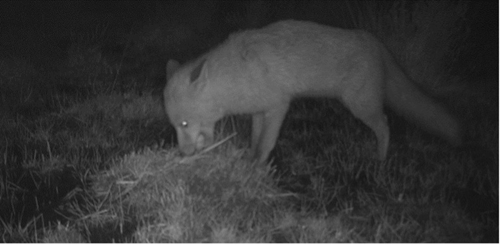By Mike Short, Head of Predation Management Research
Lowland wet grasslands, such as the meadows within the Avon Valley in Hampshire, are important for breeding waders, and there has been a long-history of agri-environment payments to landowners to provide suitable habitat for them. However, until 2015, monitoring of birds over several decades by GWCT scientists showed that, for lapwings breeding here, on average 61% of nesting attempts fail and that 82% of nest failure is caused by predation.
Wildlife managers can mitigate fox predation risk to waders during the nesting season, using both lethal control as well as non-lethal control methods, typically electrified fencing. Fox-tagging research as part of the EU LIFE+ Waders for Real project sought to understand how many foxes reside within wet grassland areas in the Avon Valley, and where foxes spend their time, to inform predation management strategies.
Key findings
- Home range estimates for 35 GPS-tagged foxes in two wet grassland sites ranged from 0.13 to 1.24 km2. These estimates implied minimum densities of >10 foxes/km2 at one site, similar to densities typically recorded in urban areas.
- Activity levels were highest during evening twilight and night.
- Fox density may be subsidised by anthropogenic food sources.
Foxes and waders
It is widely recognised that the red fox is a significant predator of ground-nesting birds, and it is implicated in declines of wading bird populations throughout Europe. In the UK there is limited knowledge on fox ecology in wet grassland habitats, so wildlife managers must use educated guesswork and prior experience to guide where and when to apply management effort. Improved understanding of fox home range size and density in wet grassland, when and where they are active, and how they move across the landscape during this critical period for breeding waders could help to reduce their impacts.
Tagging foxes
We used humane cable restraints (HCRs) to catch and GPS-tag 35 foxes in the March-June wader nesting season. Tags were programmed to provide GPS locations every 10 minutes. We worked on two contrasting wet grassland sites in the Avon Valley: on farmland at Britford in the upper valley in 2016/17 and near Somerley in the lower valley in 2018/19. The extent and structure of the wet grassland habitats differed between sites, as did predator management effort with no fox control at Britford. Both sites consisted of good quality wader nesting and chick-rearing habitat, but at Britford no waders had been recorded breeding since 2010.

Fox density
Over four years we recorded >150,000 GPS-location fixes and used these to estimate fox home range areas. Mean home ranges at Britford (0.21 km2) were significantly smaller than at Somerley (0.68 km2). At Somerley, minimum density averaged across years was 2.4 foxes/km2, which is at the upper end of the expected range given estimates in other farmland habitats. Minimum density at Britford was over four times greater at 10.6 foxes/km2.
Such exceptionally high densities have only previously been recorded in urban areas. One reason why fox densities were so high at Britford could be the lack of lethal control for the past couple of decades, while the fox population at Somerley is managed to protect livestock and released gamebirds. Another is food availability. At Britford, the relict water meadows rarely flood and provide excellent year-round vole habitat. However, perhaps more important is the availability of dead fish from a trout farm, which provides a bountiful anthropogenic food resource.

Fox activity
Data on daily fox activity patterns and movement behaviour of each fox from tags and trail camera data showed that, unsurprisingly, foxes were more active and moved faster during evening twilight and nightfall, confirming these time periods as optimal for night-shooting, where it is practicable. However, tagging showed that some foxes resided only within water meadows where safe-shooting opportunities and effective use of electric fences would have been severely constrained by landscape features and poor access. Here, careful use of HCR’s, as were used for GPS-tagging would provide an alternative method of controlling fox predation. Foxes were active for more of the night at Somerley where home ranges were larger. They were active for around one-third of daylight hours, and activity increased during the nesting season as the demands of feeding growing fox cubs increase.
Management implications
Given the continued availability of good quality habitat, it is entirely plausible that waders no longer breed in the upper Avon Valley due to very high levels of predation. This ground-breaking study illustrates the immense challenges facing breeding wading bird populations in the English lowlands. There is an urgent need to effectively manage fox predation pressure if populations of wading birds like lapwing, redshank and curlews are to recover. The challenges are immense but real, and wildlife managers will need to be properly funded and equipped to mitigate the impact of foxes that benefit from human activities.
This study was recently published in the European Journal of Wildlife Research and can be read here.